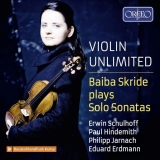Die Geigerin Baiba Skride hat sich vier Solosonaten für ihr Instrument vorgenommen, an die sicherlich nicht jeder als erste denkt, wenn er Gattungsbeiträge benennen soll. Umso spannender ist diese Zusammenstellung. Die Werke entstanden zwischen 1913 und 1927.
Insbesondere das Werk von Jarnach zählt wie der Komponist als solcher zu den Vergessenen. Die Widmung der Sonate für den Kollegen Max Reger bietet gleich einen Hinweis auf den Charakter der Komposition. In seiner Solosonate pflegt Schulhoff sein Bekenntnis zur Modernität: Schroffe, aggressive Ecksätze lehnen sich eng an Bartók an; im schwermütigen Andante sostenuto erklingen dagegen düstere, fast expressionistische Farben. In der Sonate von Erdmann ist das Spannungsverhältnis zwischen der atonalen Harmonik und dem formal klassizistischen Formverständnis besonders reizvoll. Bei Hindemith spiegelt die Sonate seine musikalische Spontaneität wider. Berühmt sind auch der Variationssatz auf ‘Komm, lieber Mai’ und der Schlusssatz als Perpetuum mobile.
Skride gelingt es eindrucksvoll, die verschiedenen Charaktere dieser vier recht kurzen Sonaten, zusammen nur mehr als eine Dreiviertelstunde Dauer, jeweils so effektvoll wie elegant zu betonen. Mühelos lässt sie die Klänge erblühen und hüpft leicht über alle technischen Schwellen. So bietet sie die Variationen bei Hindemith eloquent, aber so simpel wie ein Kinderlied während sie etwa die akademischere Schreibweise von Jarnach auch mit der nötigen Strenge darlegen kann. Diese in Hamburg beheimatete lettische Violinistin steht vielleicht nicht immer in erster Reihe, aber dass sie ihr Metier beherrscht und exzellent umzusetzen weiß, kann sie immer wieder beweisen.
The violinist Baiba Skride plays four solo sonatas for her instrument, which certainly not everyone thinks of first when asked to name genre contributions. All the more exciting is this compilation. The works were composed between 1913 and 1927.
The work by Jarnach in particular, like the composer as such, is among the forgotten. The dedication of this work to his colleague Max Reger immediately offers a clue to the character of the composition. In his solo sonata Schulhoff cultivates his commitment to modernity: gruff, aggressive corner movements lean closely toward Bartók; in the melancholy Andante sostenuto, on the other hand, somber, almost expressionistic colors resound. In Erdmann’s sonata, the tension between the atonal harmony and the formal classicist understanding of form is particularly appealing. In Hindemith’s case, the sonata reflects his musical spontaneity. The variation movement on Komm, lieber Mai and the final movement as perpetuum mobile are also famous.
Skride succeeds impressively in characterizing each of these four rather short sonatas, together lasting only more than three-quarters of an hour, as effectively as elegantly. Effortlessly, she allows the sounds to blossom and leaps easily over all technical thresholds. She offers Hindemith’s variations eloquently, but as simply as a nursery rhyme, while she can also present Jarnach’s more academic writing with the necessary rigor. This Hamburg-based Latvian violinist may not always be in the forefront, but she is able to demonstrate that she is a master of the violin and knows how to perform excellently in various repertoires.























